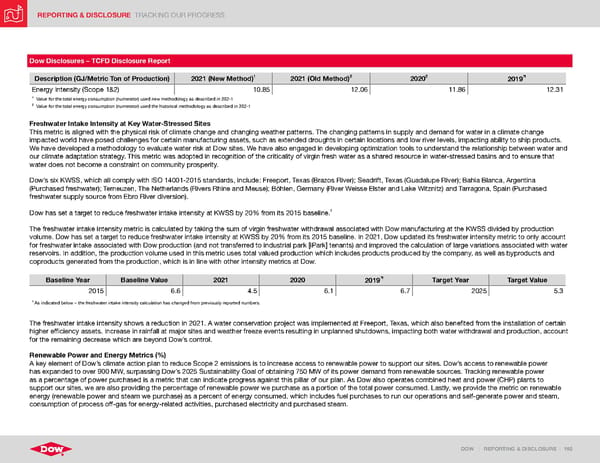REPORTING & DISCLOSURE TRACKING OUR PROGRESS DOW | REPORTING & DISCLOSURE | 192 Dow Disclosures – TCFD Disclosure Report Description (GJ/Metric Ton of Production) 2021 (New Method) 1 2021 (Old Method) 2 2020 2 2019 Energy Intensity (Scope 1&2) 10.85 12.06 11.86 12.31 1 Value for the total energy consumption (numerator) used new methodology as described in 302-1 2 Value for the total energy consumption (numerator) used the historical methodology as described in 302-1 Freshwater Intake Intensity at Key Water-Stressed Sites This metric is aligned with the physical risk of climate change and changing weather patterns. The changing patterns in supply and demand for water in a climate change impacted world have posed challenges for certain manufacturing assets, such as extended droughts in certain locations and low river levels, impacting ability to ship products. We have developed a methodology to evaluate water risk at Dow sites. We have also engaged in developing optimization tools to understand the relationship between water and our climate adaptation strategy. This metric was adopted in recognition of the criticality of virgin fresh water as a shared resource in water-stressed basins and to ensure that water does not become a constraint on community prosperity. Dow’s six KWSS, which all comply with ISO 14001-2015 standards, include: Freeport, Texas (Brazos River); Seadrift, Texas (Guadalupe River); Bahia Blanca, Argentina (Purchased freshwater); Terneuzen, The Netherlands (Rivers Rhine and Meuse); Böhlen, Germany (River Weisse Elster and Lake Witznitz) and Tarragona, Spain (Purchased freshwater supply source from Ebro River diversion). Dow has set a target to reduce freshwater intake intensity at KWSS by 20% from its 2015 baseline. 1 The freshwater intake intensity metric is calculated by taking the sum of virgin freshwater withdrawal associated with Dow manufacturing at the KWSS divided by production volume. Dow has set a target to reduce freshwater intake intensity at KWSS by 20% from its 2015 baseline. In 2021, Dow updated its freshwater intensity metric to only account for freshwater intake associated with Dow production (and not transferred to industrial park [iPark] tenants) and improved the calculation of large variations associated with water reservoirs. In addition, the production volume used in this metric uses total valued production which includes products produced by the company, as well as byproducts and coproducts generated from the production, which is in line with other intensity metrics at Dow. Baseline Year Baseline Value 2021 2020 2019 Target Year Target Value 2015 6.6 4.5 6.1 6.7 2025 5.3 1 As indicated below – the freshwater intake intensity calculation has changed from previously reported numbers. The freshwater intake intensity shows a reduction in 2021. A water conservation project was implemented at Freeport, Texas, which also benefited from the installation of certain higher efficiency assets. Increase in rainfall at major sites and weather freeze events resulting in unplanned shutdowns, impacting both water withdrawal and production, account for the remaining decrease which are beyond Dow’s control. Renewable Power and Energy Metrics (%) A key element of Dow’s climate action plan to reduce Scope 2 emissions is to increase access to renewable power to support our sites. Dow’s access to renewable power has expanded to over 900 MW, surpassing Dow’s 2025 Sustainability Goal of obtaining 750 MW of its power demand from renewable sources. Tracking renewable power as a percentage of power purchased is a metric that can indicate progress against this pillar of our plan. As Dow also operates combined heat and power (CHP) plants to support our sites, we are also providing the percentage of renewable power we purchase as a portion of the total power consumed. Lastly, we provide the metric on renewable energy (renewable power and steam we purchase) as a percent of energy consumed, which includes fuel purchases to run our operations and self-generate power and steam, consumption of process off-gas for energy-related activities, purchased electricity and purchased steam.
 ESG Report | Dow Page 191 Page 193
ESG Report | Dow Page 191 Page 193